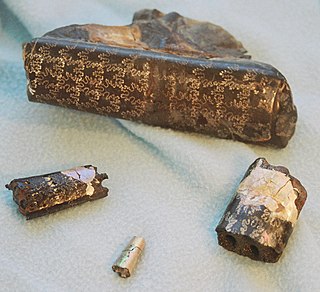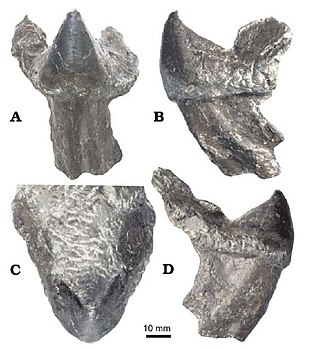
Ammonoids are a group of extinct marine mollusc animals in the subclass Ammonoidea of the class Cephalopoda. These molluscs, commonly referred to as ammonites, are more closely related to living coleoids than they are to shelled nautiloids such as the living Nautilus species. The earliest ammonites appeared during the Devonian, with the last species vanishing during the Cretaceous–Paleogene extinction event.

Baculites is an extinct genus of cephalopods with a nearly straight shell, included in the heteromorph ammonites. The genus, which lived worldwide throughout most of the Late Cretaceous, and which briefly survived the K-Pg mass extinction event, was named by Lamarck in 1799.

The Maastrichtian is, in the ICS geologic timescale, the latest age of the Late Cretaceous Epoch or Upper Cretaceous Series, the Cretaceous Period or System, and of the Mesozoic Era or Erathem. It spanned the interval from 72.1 to 66 million years ago. The Maastrichtian was preceded by the Campanian and succeeded by the Danian.
The Danian is the oldest age or lowest stage of the Paleocene Epoch or Series, of the Paleogene Period or System, and of the Cenozoic Era or Erathem. The beginning of the Danian is at the Cretaceous–Paleogene extinction event 66 Ma. The age ended 61.6 Ma, being followed by the Selandian.
Anagaudryceras is an extinct genus of ammonite from the later Cretaceous belonging to the Ammonoidea family Gaudryceratidae. Anagaudryceras has a moderately involute shell with a deep umbilicus and strongly ribbed outer whorl. Ribs are thick and rounded and cross over the venter uninterrupted.

Pachydiscus is an extinct genus of ammonite from the Late Cretaceous and Early Paleocene with a worldwide distribution, and type for the desmoceratacean family Pachydiscidae. The genus' type species is P. neubergicus. Altogether some 28 species have been described.

Discoscaphites is an extinct genus of ammonite. This genus may have been one of the few to have briefly survived the K-Pg mass extinction.

Jeletzkytes is an extinct genus of scaphatoid ammonite from the Upper Cretaceous (Maastrichtian) of North America named and described by Riccardi, 1983. In overall form Jeletzkytes closely resembles the genus Scaphites.

Dakotasuchus is a genus of goniopholidid mesoeucrocodylian. Its fossils have been recovered from the Cenomanian-age Upper Cretaceous Dakota Sandstone of Kansas. The type specimen was found in an iron-cemented sandstone concretion near Salina. This concretion was broken into two large pieces; more of the specimen was probably present originally, but by the time it was found only the torso and short portions of the neck and tail remained. Twenty pairs of bony scutes ran down the midline of the back. The vertebrae lacked the procoelous articulation of more derived crocodyliforms. Dakotasuchus had short broad shoulder blades, suggesting it had stout powerful forelimbs and perhaps terrestrial habits. M. G. Mehl, who described the genus, estimated the length of the type individual when complete to have been 3–4 metres (9.8–13.1 ft). The type species is D. kingi, named for Professor King, a former dean of Kansas Wesleyan University. Mehl did not classify his new genus to a more inclusive group than Mesosuchia. Robert Carroll assigned Dakotasuchus to Goniopholididae in 1988. In 2017, fossils of Dakotasuchus kingi which consisted of a coracoid, scutes, a dorsal vertebrate and postcranial bones were found in Utah, specifically in the Cedar Mountain Formation's Mussentuchit Member.

Sphenodiscus is an extinct genus of acanthoceratacean ammonite. The genus has been found from many continents and is thought to have had a large global distribution during the Maastrichtian stage of the Late Cretaceous. It was one of the last ammonoids to have evolved before the entire subclass became extinct during the Paleocene, which was directly after the Cretaceous–Paleogene extinction event.
This list, 2013 in molluscan paleontology, is a list of new taxa of ammonites and other fossil cephalopods, as well as fossil gastropods, bivalves and other molluscs that have been described during the year 2013.

Scaphitidae is a family of extinct cephalopods belonging to the family of heteromorph ammonites. There is a possible fossil record of them being the last ammonites with fossils dating to the Danian of the Paleocene in Denmark, The Netherlands, The US and Turkmenistan.
Dromaeosauripus is an ichnogenus that has been attributed to dromaeosaurs. Dromaeosauripus footprints have been found at Dinosaur Ridge in the United States, Bito Island Tracksite in South Korea's Bito Island, and the Hekou Group in China.
This list, 2018 in paleomalacology, is a list of new taxa of ammonites and other fossil cephalopods, as well as fossil gastropods, bivalves and other molluscs that are scheduled to be described during the year 2018, as well as other significant discoveries and events related to molluscan paleontology that are scheduled to occur in the year 2018.

Haboroteuthis is an extinct genus of squid that lived during the Cretaceous period. The only species that has been classified in the genius is H. poseidon.

The term Paleocene ammonites describes families or genera of Ammonoidea that may have survived the Cretaceous–Paleogene extinction event, which occurred 66.043 million years ago. Although almost all evidence indicated that ammonites did not survive past the K–Pg boundary, there is some scattered evidence that some ammonites lived for a short period of time during the Paleocene epoch, although none survived the Danian ; they were likely extinct within 500,000 years of the K-Pg extinction event, which correlates to roughly 65.5 Ma. The evidence for Paleocene ammonoids is rare and remains controversial.

Kenolamna is an extinct genus of mackerel shark from the Cretaceous period known only from isolated teeth. It is named in honor of Kenneth McNamara, former curator of Paleontology at the Western Australian Museum. It is tentatively placed in the family Otodontidae, and is closest in design to Cretalamna and Paleocarcharodon though it is unclear how closely related it is to either. Currently, it is a monotypic genus containing only the species K. gunsoni.
This list of fossil molluscs described in 2021 is a list of new taxa of fossil molluscs that were described during the year 2021, as well as other significant discoveries and events related to molluscan paleontology that occurred in 2021.

Eubaculites is an extinct genus of cephalopods in the family Baculitidae and each known species was initially placed within the related genus Baculites until it was placed in a separate genus in 1926.

The Rødvig Formation is a geological formation deposited during the earliest part of the Danian and it was first identified by Richard Taylor and Richard Phillips in 1827. It is known from exposures at Stevns Klint in Denmark. The unit lies directly above the K–Pg boundary and contains fossils that provide a record of the recovery of various groups following the Cretaceous–Paleogene extinction. The upper boundary of the formation is an unconformity in the form of a hardground, beneath which the formation is sometimes missing. The base of the unit is irregular due to the presence of mounding associated with bryozoa, causing variations in thickness. The unit is subdivided into the lower Fiskeler Member mainly formed of marl and the overlying Cerithium Limestone Member.














